Jump to:
Introduction
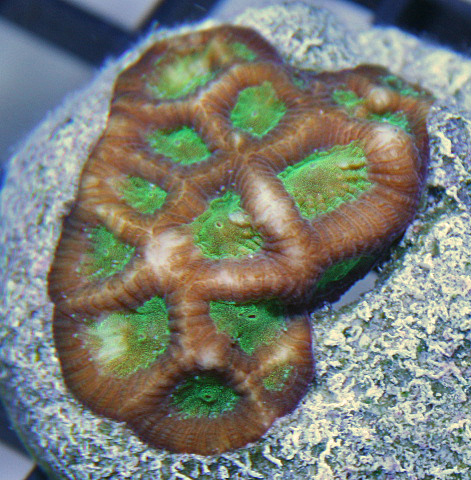
Faviidae corals are typically called faviids. These LPS (large polyped stony) corals</a > are rather popular for aquarium hobbyists and have the second largest number of species per family (compare to Acroporidae). All faviids contain zooxanthellae and are considered to be reef building (hermatypic). Some common names for faviids include brain coral, pineapple coral, candy or candy cane coral, and moon coral.
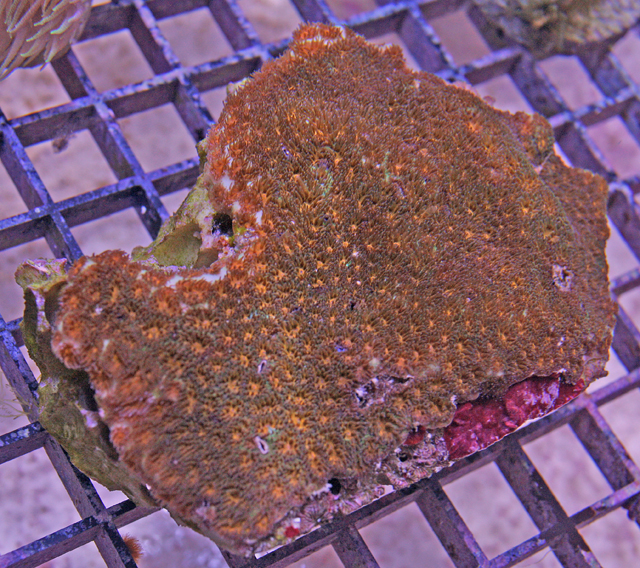
Faviidae corals are in the order Scleractinia (stony corals) and the subclass Hexacorallia (or also known as Zoantharia). Being in the Hexacorallia subclass means that the polyps have tentacles in multiples of six. The Faviidae genera are as follows: Austrologyra, Barabattoia, Caulastrea, Cyphastrea, Diploastrea, Echinopora, Favia, Favites, Goniastrea, Leptastrea, Leptoria, Montastrea, Moseleye, Oulastrea, Oulophyllia, Platygyra, Plesiastrea. </em >Not all of these genera will be covered at this time. Please scroll to the bottom of the page for more information about specific genera.
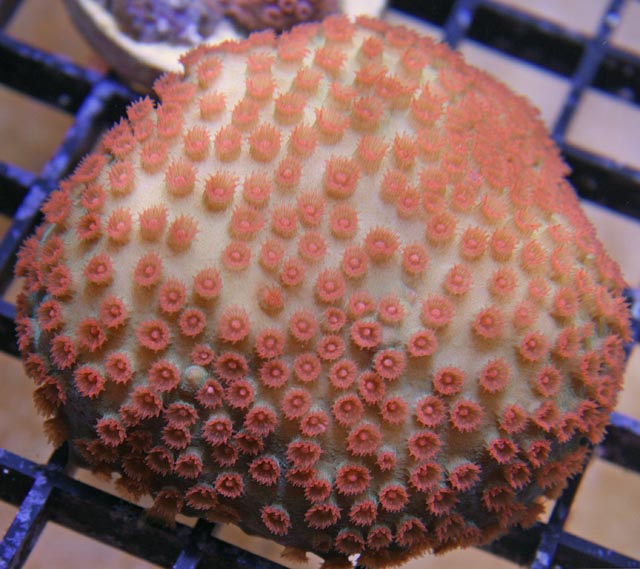
Faviid corals are heterotrophic. They gain their energy from their zooxanthellae (dinoflagellate algae) and capturing prey, such as brine shrimp. They cannot survive on photosynthesis alone. Colonies of faviids are commonly massive, hemispherical, foliaceous, and cup shaped. Few are branched. Younger colonies may begin as an encrusting form. Different genera of Faviidae can usually be distinguished by their corallites, being phaceloid (corallites arise separately from the skeleton), plocoid (corallites are close but still have separate corallite walls), ceroid (corallites share a fused wall with adjacent corallites), and meandroid (the corallite walls fuse lengthwise, “meandering” like a maze on the surface of the colony). Species will be exclusively phaceloid or cerioid, but meandroid colonies may have some cerioid corallites
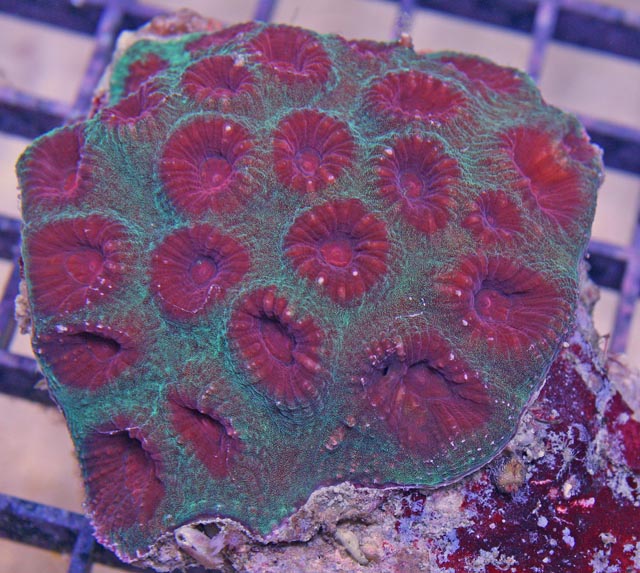
Generally speaking, faviids prefer high lighting intensity and strong water current. This is similar to their preferred habitat of reef flats and upper reef slopes. Many are accustomed to variations in salinity or exposure to fresh air, due to the dynamic environment found on Red List of Threatened Species, and an aquacultured variety in recommended. They propagate well through budding, but do not respond as well to fragmentation (most likely due to their cerioid structure).
In general, Favites requires high intensity lighting and moderate current. Beware of using too strong of a current, because it could prevent the polyps from fully extending. Favites are aggressive, so give them room in your aquarium. Favites spp. generally has the same care requirements as Favia spp., so check out this article for more specific care information on the Favites genus</a >.
Genera
Leptoria
Check our current stock</a >Common Species: L. irregularis, L. phrygia
Common Names for Leptoria corals are maze coral, brain coral, closed brain coral, and labyrinth coral. Labyrinth corals are quite meandroid, with steep corallite walls which resemble the walls of a maze. Leptoria corals can be brown, green, or cream, with eyes in colors of cream, white, or bright green.
These are not often imported or aquacultured. The colonies due not survive fragmentation well. If you are able to acquire a specimen, they prefer high light intensity, moderate water flow, and clearer water. Use of a skimmer would be appropriate to keep nutrient levels low. Leptoria corals do produce large amounts of mucus. Labyrinth corals are considered very aggressive, so they will need ample space in the aquarium.
Montastrea
Check our current stock</a >Common Species: M. annularis, M. annuligera, M. cavernosa, M, colemani, M. curta, M. valenciennesi</em >
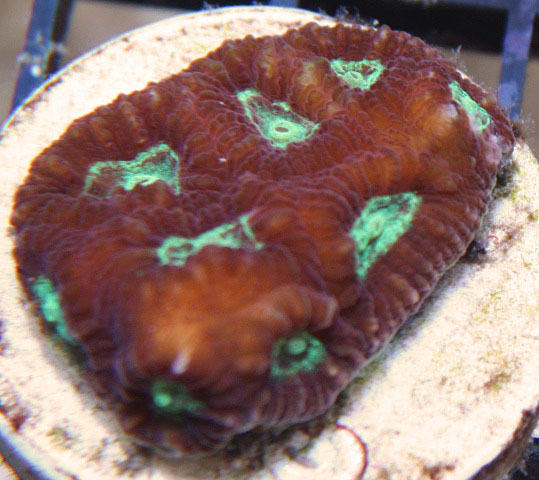
Common names for Montastrea corals are brain coral, closed brain coral, boulder coral, great star coral, and pineapple coral. Boulders are typically massive or hemi-spherical and are often found on reef flats, but can also be laminar in form in the deeper reef habitats. It may be brown, green, or white, sometimes within the same colony.
As with most faviids, Montastrea spp. are considered hardy. They prefer high intensity light and moderate to strong water current. As would be expected with species found on the flats, they are tolerant of exposure to fresh air and changes in salinity. Reef flats commonly receive and influx of fresh water in rain showers and are exposed to air in low tide. Be careful with placement in your aquarium, as they are considered aggressive, and form long sweeper tentacles.
Oulophyllia
Check our current stock</a >Common Species: O. bennettae, O. crispa, O. levis</em >, O. aspera
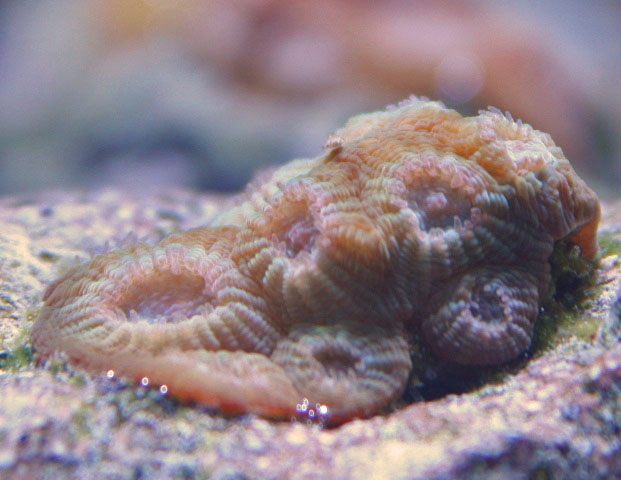
Common names for Oulophyllia are brain coral, closed brain coral, maze coral, and ejection-seat coral. O. levis and O. crispa are common in lagoons, and O. bennettae prefer reef slopes. These corals are massive and meandroid. Ejection-seat corals have distinctly v-shaped corallite walls and large polyps. They are commonly brown, green, or cream. The eyes are usually cream or pinkish. Oulophyllia corals gain their name from their ability to “eject” their polyps. Although these are hardy, they are less common in the aquarium trade. Typically, they are found in lagoons.
Platygyra
Check our current stock</a >Common Species: P. pini, P. verweyi, P. daedalea, P. lamellina, P. sinensis
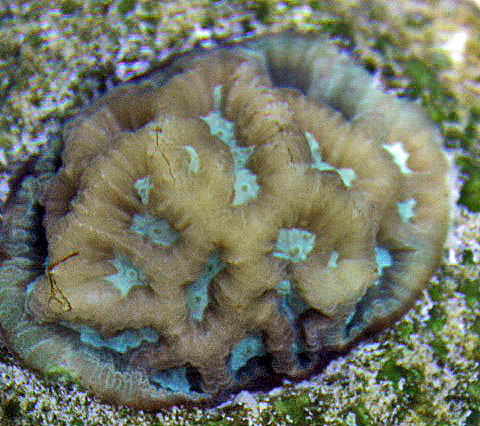
Common names for Platygyra are maze coral, brain coral, and closed brain coral. These are quite meandroid and form massive, dome-shaped, or flat colonies. They are commonly brown, green, cream, or yellow, with contrasting eye/valley colors. Maze corals are found mainly on reef flats, and back slopes.
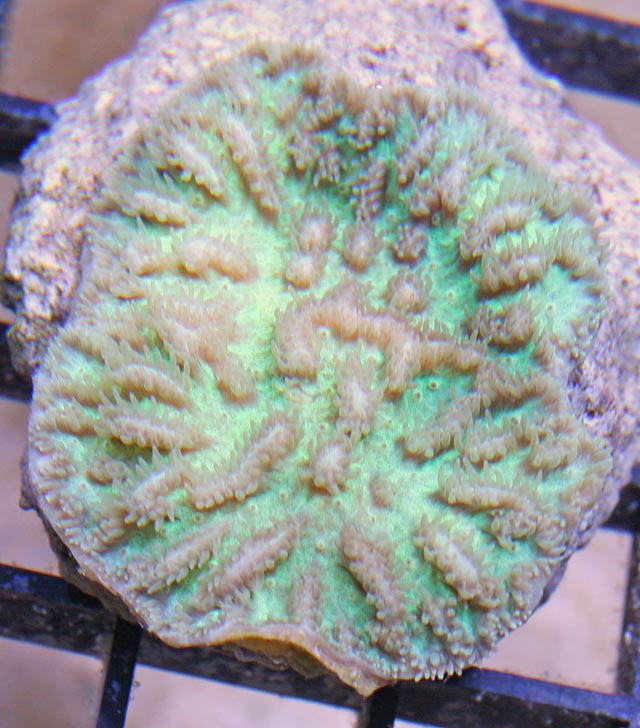
Platygyra spp.are considered to be hardy, but may be prone to bleaching. As with other faviids, these maze brain corals form sweeper tentacles, especially at night, and therefore should be given room in your reef aquarium. Similar to Leptoria, Platygrya creates copious amounts of mucus. (As they are common on reef flats, this may be a method they've evolved to deal with exposure to air at low tide.) Please see this article for more specific care information on the Platygyra genus</a >.
References
Borneman, E. (2001). Aquarium Corals: selection, husbandry, and natural history. Neptune City, NJ: T.F.H Publications.
Brain Coral. (2011). Wikipedia. Retrieved on June 21, 2011, from http://en.wikipedia.org/wiki/Brain_coral</a >
Calfo, A.R. (2002). Book of Coral Propagation: A concise guide to the successful care and culture of coral reef invertebrates </em >(Vol. 1). Monroeville, PA: Reading Trees.
IUCN 2010. (2011). IUCN Red List of Threatened Species. Version 2010.4. Retrieved on June 9th, 2011, from www.iucnredlist.org</a >
Reef Corals of the Indo-Malaysian Seas. (2011). Marine Species Identification Portal</em >. Retrieved on June 10, 2011, from http://species-identification.org/species.php?species_group=corals&id=48&menuentry=groepen</a >
Veron, J.E.N. (1986). Corals of Australia</em > and the Indo-Pacific. North Ryde, Australia: Angus & Robertson.
Veron, J.E.N. (2000). Corals of the World. Townsville, Australia: Australian Institute of Marine Science.
Wood, E.M. (1983). Reef Corals of the World: Biology and Field Guide. Hong Kong, China: T.F.H. Publications Inc., Ltd.
